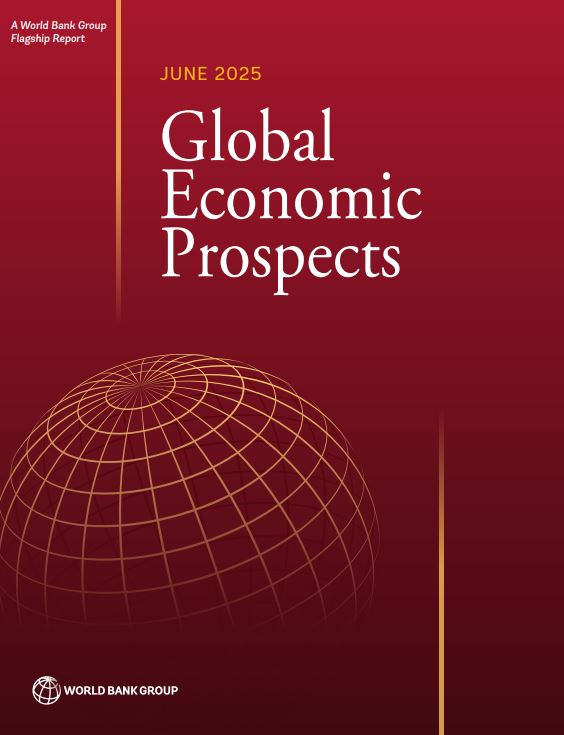ㅇ 세계은행은 6월 10일 발표한 「세계 경제전망 보고서(Global Economic Prospects, June 2025)」에서 높아진 무역 관련 긴장과 정책의 불확실성을 이유로 이같이 밝힘
ㅇ 전 세계 성장률 2.3%는 글로벌 금융위기와 코로나19 팬데믹 경기침체기(recession)를 제외하면 2008년 이래 최저치가 될 것으로 예상됨
ㅇ 전세계 경제 주체의 70%에 대해 올해 성장률 전망치를 하향했다고 세계은행은 밝힘
□ 주요 국가 및 지역의 성장률 전망치도 하향 조정되었으며, 개발도상국 및 저소득 국가도 영향을 받을 것으로 예상됨
ㅇ 관세 전쟁을 시작한 미국은 올해 1.4% 성장이 예상되며, 이는 작년 성장률(2.8%)의 절반 수준이자 1월 예상치(2.3%)보다 0.9% 포인트 낮은 것임
ㅇ 미국과 가장 격렬한 무역 전쟁 중인 중국은 올해 4.5% 성장이 예상되나, 이는 작년 대비 0.5% 포인트 하락한 수치임
ㅇ 유로존은 0.7% 성장, 일본은 0.7% 성장이 각각 예상되며, 이는 1월 예상치보다 하향 조정된 것임
ㅇ 한국이 포함된 동아시아·태평양 지역은 올해 4.5%로 둔화되고 내년 4%로 더 내려갈 것으로 예상되며, 이는 1월 수치 대비 각각 0.1% 포인트 하향된 것임
ㅇ 개발도상국 전체 성장률도 3.8%로 하향 조정되어 2010년대 평균(5%대)보다 1% 포인트 이상 낮아질 것으로 예측됨
ㅇ 저소득 국가들의 올해 성장률 역시 5.3%로 올해 초 대비 0.4% 포인트 하향 조정됨
ㅇ 글로벌 물가상승률 예상치는 관세 영향을 감안하여 올해 평균 2.9%로 상향 조정됨
□ 세계은행은 무역 긴장 완화 시 성장률 반등 가능성을 언급하며 정책 방향 수정의 중요성을 강조함
ㅇ 주요 경제국들이 무역 긴장을 완화하여 5월 말의 관세 수준을 절반으로 낮춘다면, 2025년과 2026년 글로벌 성장률이 평균 0.2% 포인트 상승할 것으로 예상됨
ㅇ 세계은행 수석 이코노미스트는 높은 정책 불확실성과 무역 관계 해체 추이가 전망 악화의 원인이며, 신속한 방향 수정 없이는 생계 수준에 심각한 악영향이 있을 수 있다고 언급함
ㅇ 글로벌 경기 침체는 예상되지 않지만, 향후 2년간의 경제 전망이 현실화될 경우 2020년대 첫 7년간의 평균 경제 성장은 1960년대 이래 최저치가 될 것이라고 내다봄
[출처] WB, 관세전쟁속 올 세계성장률 2.3%로 하향…美 '반토막' 예상 (2025.06.11.) / 연합뉴스
목차
Title page 1
Contents 6
ACKNOWLEDGMENTS 10
FOREWORD 11
EXECUTIVE SUMMARY 13
ABBREVIATIONS 15
CHAPTER 1. GLOBAL OUTLOOK 16
Summary 17
Global context 22
Global trade 22
Commodity markets 23
Global inflation 24
Global financial developments 25
Major economies: Recent developments and outlook 26
Advanced economies 26
China 28
Emerging market and developing economies 29
Recent developments 29
EMDE outlook 30
LICs outlook 32
Per capita income growth 38
Global outlook and risks 45
Summary of global outlook 45
Risks to the outlook 45
Policy challenges 52
Key global challenges 52
EMDE monetary and financial policy challenges 54
EMDE fiscal policy challenges 55
EMDE structural policy challenges 57
References 61
CHAPTER 2. REGIONAL OUTLOOKS 65
EAST ASIA and PACIFIC 66
Recent developments 66
Outlook 67
Risks 69
EUROPE and CENTRAL ASIA 73
Recent developments 73
Outlook 74
Risks 77
LATIN AMERICA and THE CARIBBEAN 81
Recent developments 81
Outlook 82
Risks 85
MIDDLE EAST and NORTH AFRICA 89
Recent developments 89
Outlook 90
Risks 93
SOUTH ASIA 97
Recent developments 97
Outlook 98
Risks 100
SUB-SAHARAN AFRICA 104
Recent developments 104
Outlook 105
Risks 108
References 111
STATISTICAL APPENDIX 113
DATA AND FORECAST CONVENTIONS 118
SELECTED TOPICS 7
Tables 8
TABLE 1.1. Real GDP 18
TABLE 1.2. Emerging market and developing economies 60
TABLE 2.1.1. East Asia and Pacific forecast summary 71
TABLE 2.1.2. East Asia and Pacific country forecasts 72
TABLE 2.2.1. Europe and Central Asia forecast summary 79
TABLE 2.2.2. Europe and Central Asia country forecasts 80
TABLE 2.3.1. Latin America and the Caribbean forecast summary 87
TABLE 2.3.2. Latin America and the Caribbean country forecasts 88
TABLE 2.4.1. Middle East and North Africa forecast summary 95
TABLE 2.4.2. Middle East and North Africa economy forecasts 96
TABLE 2.5.1. South Asia forecast summary 103
TABLE 2.5.2. South Asia country forecasts 103
TABLE 2.6.1. Sub-Saharan Africa forecast summary 109
TABLE 2.6.2. Sub-Saharan Africa country forecasts 110
Figures 7
FIGURE 1.1. Global economic prospects 19
FIGURE 1.2. Global economic prospects (continued) 20
FIGURE 1.3. Global trade 23
FIGURE 1.4. Commodity markets 24
FIGURE 1.5. Global inflation 25
FIGURE 1.6. Global financial developments 26
FIGURE 1.7. Major economies: Recent developments and outlook 27
FIGURE 1.8. Recent developments in emerging market and developing economies 30
FIGURE 1.9. Outlook for emerging market and developing economies 31
FIGURE 1.10. Per capita income growth 38
FIGURE 1.11. Global outlook 46
FIGURE 1.12. Risks to the outlook 47
FIGURE 1.13. Global policy challenges 53
FIGURE 1.14. EMDE monetary and financial policy challenges 55
FIGURE 1.15. EMDE fiscal policy challenges 56
FIGURE 1.16. EMDE structural policy challenges 58
FIGURE 2.1.1. China: Recent developments 67
FIGURE 2.1.2. EAP excluding China: Recent developments 68
FIGURE 2.1.3. EAP: Outlook 69
FIGURE 2.1.4. EAP: Risks 70
FIGURE 2.2.1. ECA: Recent developments 74
FIGURE 2.2.2. ECA: Outlook 75
FIGURE 2.2.3. ECA: Risks 77
FIGURE 2.3.1. LAC: Recent developments 82
FIGURE 2.3.2. LAC: Outlook 83
FIGURE 2.3.3. LAC: Risks 85
FIGURE 2.4.1. MNA: Recent developments 90
FIGURE 2.4.2. MNA: Outlook 91
FIGURE 2.4.3. MNA: Risks 93
FIGURE 2.5.1. SAR: Recent developments 98
FIGURE 2.5.2. SAR: Outlook 99
FIGURE 2.5.3. SAR: Risks 101
FIGURE 2.6.1. SSA: Recent developments 105
FIGURE 2.6.2. SSA: Outlook 106
FIGURE 2.6.3. SSA: Risks 107
Boxes 7
BOX 1.1. Regional perspectives: Outlook and risks 33
BOX 1.2. Low-income countries: Recent developments and outlook 39
Box Tables 8
TABLE B1.2.1. Low-income country forecasts 42
Box Figures 8
FIGURE B1.1.1. Regional outlooks 34
FIGURE B1.1.2. Regional risks 35
FIGURE B1.2.1. LICs: Recent developments 40
FIGURE B1.2.2. LICs: Outlook and risks 41



